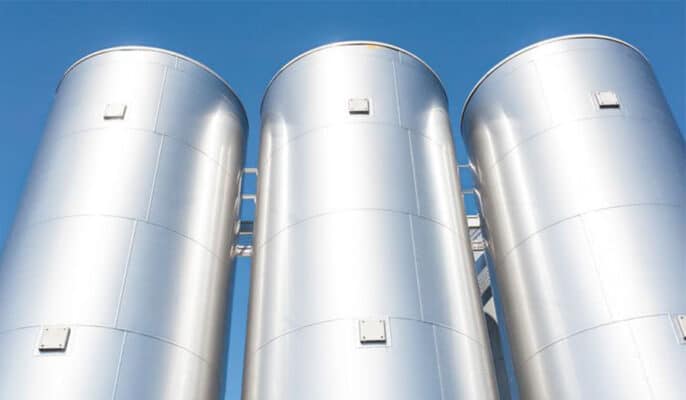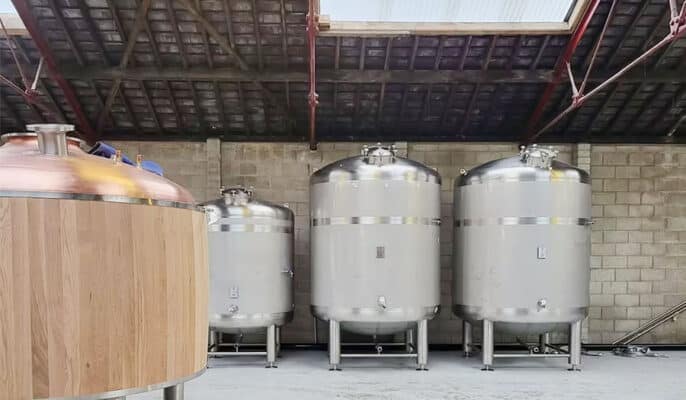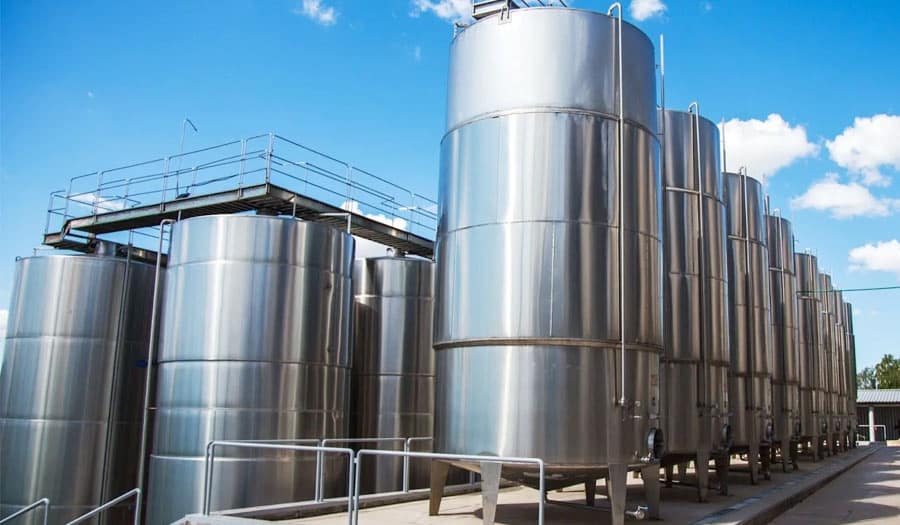Stainless steel storage tanks play a vital role in modern industry and manufacturing. Their main task is to store and process various liquid and semi-liquid substances safely and efficiently. With excellent corrosion resistance, strength, and durability, these storage tanks are widely used in many industries such as food, beverage, chemical, pharmaceutical, etc. In the food and beverage industry, stainless steel storage tanks are not only used to store raw materials, fermentation liquids, and finished products but also can effectively ensure the quality and safety of products.
스테인리스 스틸이란? 저장 탱크?
A stainless steel storage tank is a specialized tank made of stainless steel. It is mainly used to store and handle various liquid and semi-liquid substances. Due to its excellent physical and chemical properties, stainless steel tanks are widely used in many industries, such as food, beverage, chemical, and pharmaceutical.
The main features of stainless steel storage tanks include:
- Corrosion resistance: Stainless steel materials have excellent corrosion resistance, which enables these storage tanks to be used for a long time in corrosive liquid environments such as acids, alkalis, and salts without being easily damaged. This feature is particularly critical when handling chemicals or storing high-humidity liquids.
- Strength and durability: Stainless steel has excellent strength and toughness and can withstand certain pressures and mechanical shocks. Therefore, these storage tanks can safely store high-pressure or heavy substances.
- Hygiene: Stainless steel has a smooth surface and is easy to clean and disinfect, which is particularly important in the food and pharmaceutical industries because it can effectively prevent the accumulation of bacteria and contaminants, thereby ensuring the hygiene and safety of the product.
- Temperature resistance: Stainless steel storage tanks can maintain stable performance in high or low-temperature environments, so they are suitable for storage occasions that require temperature control, such as food processing and pharmaceutical production.
- Sealing: These storage tanks are usually equipped with excellent sealing systems, which can effectively prevent liquid leakage and protect the stored materials from contamination or interference from the external environment.

Main functions of stainless steel storage tanks
- Storage and preservation: These tanks provide an ideal solution for storing large-scale materials, effectively reducing the losses that may be caused by evaporation or spillage. They help achieve efficient inventory management, ensure a stable supply of materials required for continuous operations, and avoid shortages.
- Mixing and blending: Some stainless steel storage tanks are designed for mixing or blending different liquids or gases to form specific formulas or products.
- Transportation: Portable storage tanks are suitable for transporting liquids or gases over short distances, which facilitates mobile operations in production or supply chains.
- Safety and compliance: Proper storage of hazardous materials helps to meet safety and environmental regulations and ensure safety and compliance during operations.
- Buffer: Storage tanks act as buffers between production rates and consumption rates, helping to balance fluctuations in demand and supply and maintain stable production and sales.
- Versatile applications: In addition, stainless steel storage tanks are also widely used to store cleaning fluids, pharmaceuticals, chemicals, etc., and with their versatility, they play an important role in various production processes.
Types of stainless steel storage tanks can be classified according to shape, function, and special design
Shape classification
- Cylindrical storage tank: The most common type, consisting of a cylinder and a dome or flat top. Its simple geometry brings lower manufacturing costs while providing good structural strength and stability.
- Spherical storage tank: Because its round design evenly distributes internal pressure, it is suitable for storing high-pressure liquids or gases and performs stably under high pressure.
- Vertical storage tank: It is placed vertically, occupies a small area, and is suitable for environments with limited space. Under the action of gravity, the liquid flows naturally, which helps to reduce maintenance and operating costs.
- Horizontal storage tank: It is placed horizontally, suitable for spacious spaces, conducive to uniform distribution of liquids, and easy to clean and maintain.
- Double-layer storage tank: It has an inner and outer two-layer structure, the outer layer serves as a protective layer, and the inner layer is used to store liquids. The double-layer design provides additional protection and effectively prevents the influence of the external environment on the stored liquid.
Function type classification
- 발효 탱크: It is used in microbial fermentation processes and is equipped with temperature control, stirring, and gas channel systems to ensure the stability and uniformity of the fermentation process. The design focuses on cleaning, disinfection, and temperature and pressure control.
- Mixing tank: used to mix different ingredients evenly, usually equipped with a stirring device. The design focuses on mixing effect and uniformity.
- Storage tank: mainly used to store liquid or semi-liquid substances, the design focuses on storage capacity and stability, usually including opening, discharge, and liquid level monitoring systems.
Special design classification
- Insulated storage tank: add an insulation layer to the outside of the tank to keep the temperature of the internal liquid stable, and reduce energy consumption and temperature fluctuations.
- Heating/cooling storage tank: equipped with a heating or cooling system to keep the liquid within a specific temperature range, including heaters, cooling coils, or thermostats.

탱크 재료
The choice of material for building a tank is critical and depends on the chemical nature of the material to be stored, environmental conditions, cost considerations, and the expected life of the tank. These materials have different advantages and are selected based on factors such as the type of substance being stored, durability requirements, cost-effectiveness, and resistance to corrosion or chemical reactions.
- Steel: Widely used for its durability and strength. Different grades of steel offer varying degrees of corrosion resistance depending on the material being stored. It can be coated or lined to prevent corrosion and is suitable for a wide range of temperatures and pressures.
- Concrete: Large tanks used to store water, sewage, and certain chemicals. Concrete has good structural integrity and fire resistance, and is cost-effective in large-scale production.
- Polyethylene and fiberglass: These materials are used to make chemical-resistant tanks or small and medium-sized water tanks and have excellent corrosion resistance. However, they may not be suitable for high-pressure applications.
- Stainless steel: Compared with ordinary steel, stainless steel is corrosion-resistant and non-reactive, so it can be used in tanks for storing corrosive chemicals or foods.
How to keep stainless steel storage tanks safe?
Proper handling, storage, and maintenance of storage tanks, as well as regular inspections and employee training, can help prevent accidents, leaks, and fires. By following safety guidelines and regulations, companies can ensure that their storage tanks are safe and in compliance with local regulations, protecting their employees, equipment, and the environment from potential hazards.
- Fire safety measures, including fire extinguishers, smoke detectors, and automatic fire extinguishing systems, should be implemented to prevent fires. Employees who handle stored materials should be trained in safe handling, storage procedures, leak response, and emergency response. Regular training and safety meetings can reinforce safety practices and ensure that employees are aware of the risks associated with storage tanks.
- Regular inspection and maintenance of storage tanks is essential to ensure that they are working properly and prevent leaks and spills. Companies that handle bulk storage must keep records of inspections, maintenance, and testing of storage tanks and related equipment.
- Leak detection and monitoring systems, such as automatic tank gauging systems or other electronic monitoring devices, should be installed to detect leaks or spills promptly. Secondary containment systems, such as dikes or spill containment pools, should also be installed to prevent spills from spreading outside the containment area.
- Storage of other hazardous materials, such as liquefied petroleum gas, is also important. LPG storage tanks should be protected from unauthorized access to reduce the likelihood of intentional or accidental interference. LPG users have responsibilities for their tanks, including ensuring that they are in a safe condition.
How to choose a stainless steel storage tank?
- Capacity: Accurately determine the required storage capacity and avoid choosing a tank that is too large or too small. This ensures storage efficiency while avoiding unnecessary investment or capacity restrictions.
- Material selection: Select the appropriate material based on the nature and requirements of the stored substance. Common materials include steel, aluminum, polyethylene, and fiberglass, each of which has its specific advantages, such as durability and corrosion resistance.
- Comply with regulations: Make sure the selected tank meets all relevant safety and environmental regulations to prevent potential hazards and ensure compliance with legal requirements in the area.
- Safety features: Select tanks that meet safety standards and regulations, giving priority to their safety performance to reduce the risk of accidents, leaks, and environmental damage.
- Tank type: Consider different types of tanks, such as above-ground tanks, underground tanks, portable tanks, overhead tanks, etc. Choose the most appropriate tank type based on specific storage needs and site conditions.
- Cost considerations: Select a tank within your budget, ensuring a balance between cost-effectiveness and performance to meet quality and functional requirements.
- Size Alignment: Based on the available space and storage requirements, select the right size tank to ensure it fits the site and effectively accommodates the required storage volume.
- Availability and Suitability: During the selection process, ensure that the selected tank model meets the budget and requirements and is readily available when needed to meet specific storage needs.
자주 묻는 질문
What are the main uses of stainless steel storage tanks?
A: Stainless steel storage tanks are widely used to store and process various liquid and semi-liquid substances, mainly including food, beverages, chemical products, pharmaceuticals, etc. Their corrosion resistance and durability make them used in many industries, such as food processing, pharmaceutical, chemical, and beverage production.
Do stainless steel storage tanks need regular inspections?
Yes, stainless steel storage tanks should be inspected regularly to ensure their normal operation. The inspection includes checking the structure, sealing, corrosion, and other factors that may affect the function of the tank. Regular inspection and maintenance can help extend the service life of the storage tank and ensure its safety.
How long is the life of a stainless steel storage tank?
The service life of a stainless steel storage tank depends on many factors, including material, use environment, maintenance, and operating conditions. Generally speaking, 304 and 316 stainless steel storage tanks can be used for more than 15 years under normal use and maintenance conditions. However, the actual life may vary depending on the specific application and environmental conditions.




